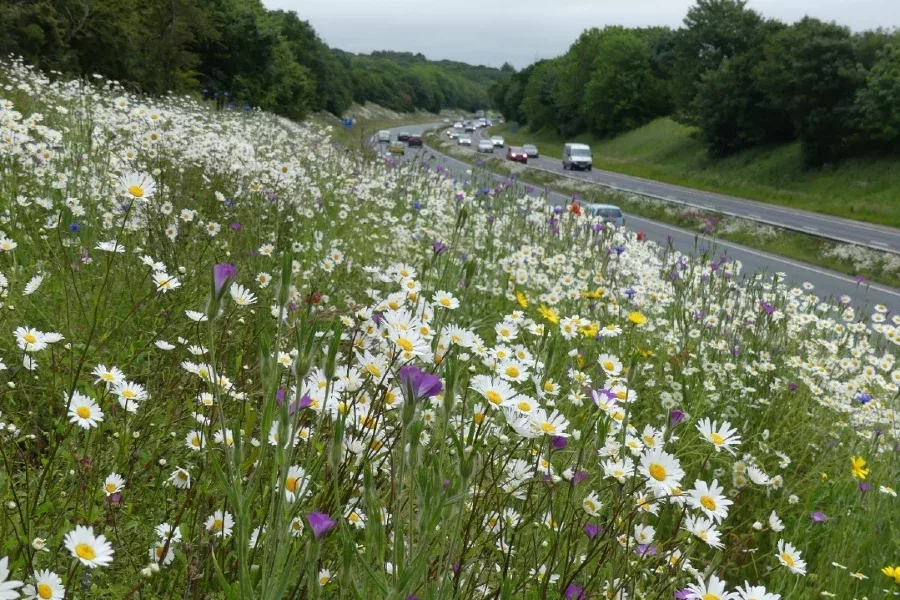National Highways has said it is working towards transforming its verges and land alongside the M4 in Wiltshire and the A46 near Bath to improve habitats for bees, butterflies…and otters.
Areas of wild and unproductive vegetation are being removed from the roadsides and re-seeded with native grasses and wildflowers over the coming weeks to create a network of species-rich grasslands, enhancing biodiversity and providing a much more wildlife friendly environment.
The company is investing £1.6 million from its Environment and Wellbeing designated funding stream on the two schemes, with work well under way on the eastbound and westbound verges of the M4 bordering the Marlborough Downs Space for Nature and the North Wessex Downs Area of Outstanding Natural Beauty.
The scheme will not only create and enhance 4.3 hectares of species-rich grassland but will also see 500 metres of fencing installed to prevent otters – populating nearby watercourses, including the River Ray – from crossing the M4 and encourage them to utilise culverts under the M4 between junctions 15 and 16.
Work also started earlier this month on the Swainswick Biodiversity scheme, which will create and enhance over five hectares of grassland between M4 junction 18 and the A4 London Road roundabout.
The area sits within the Cotswolds Area of Outstanding Natural Beauty and the new species-rich grassland will contribute to the creation of a network of grassland verges as well as improving biodiversity and the ecological value of the roadsides along the A46 and A4 near Bath.
The work follows similar schemes alongside the A38 and A30 in Devon and the A36 in Wiltshire and is being undertaken as part of National Highways’ commitment to achieving no net loss of biodiversity across its estate by the end of 2025.
Both M4 Marlborough Downs and A46 Swainswick schemes support the National Pollinators Strategy and following clearance and re-seeding work, will complete in April and May respectively. After-care work and surveys will follow over the next three years to ensure the success of the biodiversity schemes.
Among the grass and wildflower species to be seeded alongside the roadsides are Meadow Buttercup, Sweet vernal-grass, Bird’s-foot Trefoil, Yellow Rattle, Cornflowers, Common Poppies and Corn Marigold, all of which will create an enhanced environment for a declining range of pollinators and insects.
Bird’s-foot trefoil alone is a food plant for nearly 150 species of invertebrates, and as part of the schemes, ecological surveys will be undertaken at one and three-year intervals to monitor increased habitats alongside the new grassland verges.
National Highways’ Environmental Advisor Ben Hewlett said: “This is a great example of how we’re moving away from simply minimising the environmental impacts of our work towards actually improving the environment through our work.
“We have a policy to introduce low nutrient soils and wildflower verges as part of our major projects programme, and it’s good to see this spreading into our regional maintenance and improvement work.
“The increase in wildflowers will not only have wider biodiversity benefits and provide some impressive visual displays, but it will reduce long-term maintenance costs and reduce our carbon footprint through fewer maintenance visits.
“Species-rich verges and roadsides will also help to connect people with nature and improve the wellbeing of millions of people using our roads every day.”

Above, otter fencing is being installed alongside the M4 and, below, the verge after clearance and ready for seeding

National Highways manages four designated funds, allocated by the Government, to deliver benefits above and beyond building, maintaining and operating England’s strategic roads.
Enhancing biodiversity is one of National Highways’ key themes within its Environment and Wellbeing funding stream, and elsewhere in the South West, the funding stream is also enabling a number of initiatives alongside the A303 in Wiltshire, including grasslands projects and a River Avon restoration scheme.
The company has also assisted the Devon-based Westcountry Rivers Trust to install specially designed fish passes on the River Lemon under the A38 near Newton Abbot and at Ashburn Check Weirs alongside the A38 at Buckfastleigh.
And the funding stream is also enabling Cornwall Wildlife Trust to deliver environmental enhancements to the Cornish landscape bordering the A30 – helping to restore and recreate 16.8 hectares of woodland, orchard and grassland.





















